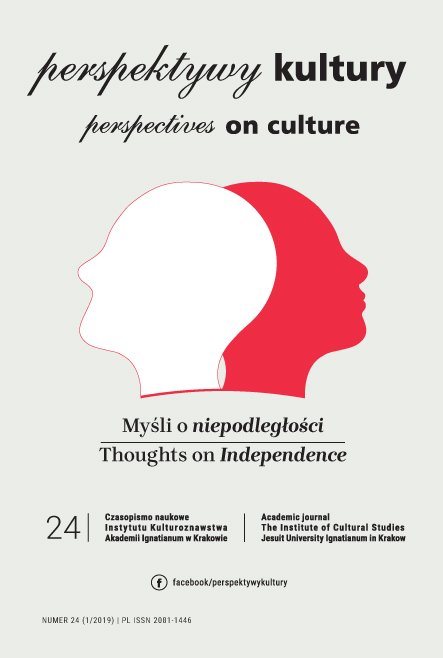From the Editors
Abstract
2018 was marked by a variety of celebrations of the 100th anniversary of Poland’s independence. Therefore, it was impossible to ignore this great event also in terms of scientific reflection. We decided to include into this and the next issue a few interesting cultural studies on various aspects of the regained independence. The first mini cycle is comprised of three articles is dominated by research on the prefiguration of what happened in 1918. Włodzimierz Toruń (KUL) analyzes a few sketches, or rather, literary essays by Cyprian Norwid, written after the fall of the January Uprising (1864), expressing the poet’s critical views on the Polish roads to national sovereignty. The Poles “know how combat” but they “do not know how to fight,” Norwid writes, at the same time pointing to the importance of spiritual independence, which in his opinion is more meaningful than the political one. Wilhelm Coindre (UKSW) turns toward interesting independence themes in the works of Maria Dąbrowska. The school strike in Kalisz in 1905 became an inspiration for that writer to undertake deep reflection about what the coming independence is to be like. The triptych is closed by the article by Karol Samsel (UW) on a little-known “post-romanticistally entangled” intellectual independence journalism of Joseph Conrad, providing a very interesting analysis from the perspective of the intertextual method, as a precise deconstruction of a highly sophisticated, elegant “literary game.”
The second part of the issue consists of a number of highly diverse, but in any case interesting essays. The team of five authors (a setting to which we are not accustomed to in the humanities): Aleksandra Smołka- Majchrzak, Jakub Lickiewicz, Thomas Nag, Conrad Ravnanger, and Marta Makara-Studzińska present the results of their research combining clinical medicine and cultural studies, analyzing the effectiveness of tools to evaluate training geared to prevent aggressive behavior towards medical staff from an intercultural perspective. Further, we include a cross-sectional, historical-cultural analysis of the significance of church music in the history of the Church by Fr. Robert Tyrała (UPJPII). An interesting proposal for interpretation of contemporary marketing strategies of book promotion, and more broadly, the “celebritization” of authors, was studied by Edyta Żyrek-Horodyska (Jagiellonian University) on the example of a journalist and writer-reporter Mariusz Szczygieł, who perfectly illustrates these transformations in the space of media activity (especially social media), where the writer becomes not only an author but also a protagonist of their work. The media study by Olga Białek-Szwed (KUL), in which the author aims to present correlations between contemporary civilization and cultural transformations and the situation of the human being as a consumer of the mass media in the 21st century, shows the specificity of some mechanisms governing contemporary media, such as media voyeurism, the so-called online living, or the metaphor of the synopticon.
The issue closes with a text by Paweł Krokosz (UPJPII), under the intriguing title Od przedawcy pierożków do generalissimusa [From pie seller to the generalissimo], bringing closer the little-known figure of Alexander Mienshykov, a man from the social lowlands, who made friends with Tsar Peter I and managed to achieve considerable wealth, prominent state positions and the highest ranks of command in the Russian army and war fleet. He even tried unsuccessfully, after the tsar’s death, to take over the leadership of all state affairs. In 1727, he was arrested and convicted to exile in Berezovo, Siberia, with his family.
As always, we wish you a pleasant and useful scientific reading!
Copyright (c) 2020 Perspectives on culture

This work is licensed under a Creative Commons Attribution-NoDerivatives 4.0 International License.
Autor, zgłaszając swój artykuł, wyraża zgodę na korzystanie przez Wydawnictwo Uniwersystet Ignatianum z utworu na następujących polach eksploatacji:
- utrwalania utworu w formie papierowej, a także na nośniku cyfrowym lub magnetycznym;
- zwielokrotnienia utworu dowolną techniką, bez ograniczenia ilości wydań i liczby egzemplarzy;
- rozpowszechniania utworu i jego zwielokrotnionych egzemplarzy na jakimkolwiek nośniku, w tym wprowadzenia do obrotu, sprzedaży, użyczenia, najmu;
- wprowadzenia utworu do pamięci komputera;
- rozpowszechniania utworu w sieciach informatycznych, w tym w sieci Internet;
- publicznego wykonania, wystawienia, wyświetlenia, odtworzenia oraz nadawania i reemitowania, a także publicznego udostępniania utworu w taki sposób, aby każdy mógł mieć do niego dostęp w miejscu i czasie przez siebie wybranym.
Wydawca zobowiązuje się szanować osobiste prawa autorskie do utworu.





